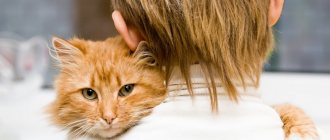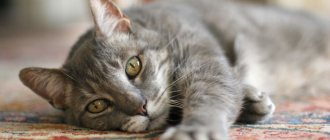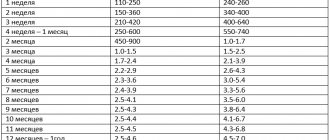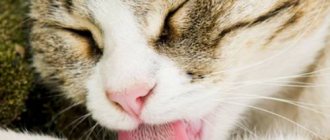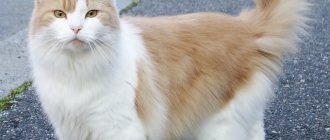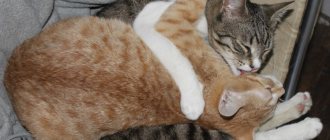Expressive cat tail gestures
A cat's tail is one of the most expressive parts of the body. With its help, she can talk about a variety of emotions and feelings. The tail can:
- move from side to side;
- twitch and tremble;
- rise vertically;
- squeeze between paws.
Active wagging of the tail indicates that the pet is irritated and excited. If at the same time the hairs on it stand on end, the tail becomes fluffy, it is advisable to leave the pet alone so as not to provoke aggression or even an attack. The tail can move horizontally and vertically.
When a cat is interested in some object, it focuses all its attention on it, the tip of its tail begins to twitch. But such a gesture can also appear during aggression. For example, it is observed when a stranger invades territory that the cat considers its own. Tail quivering also has two meanings. This movement appears when the cat leaves marks in its area. If the tail trembles when the cat is scratched, stroked, or rubs against the owners’ legs, this is a sign of affection and love.
When the pet feels a surge of happiness, he feels confident in his own importance, then the tail rises vertically. He develops an appropriately important gait and other confirming gestures. When danger appears, if the cat is afraid, it lowers its tail and places it between its hind legs. Such a gesture may also indicate that the pet feels lonely, abandoned, and unhappy.
The secret language of cats: how to decipher the behavior of pets by their tails
If you do not have enough experience with these animals, much of their behavior may seem strange or be misinterpreted. But it’s so important for us to understand them! Fortunately, having studied cats for a long time, felinologists have unraveled the behavioral language of these independent, charming creatures.
Rubbing his head against your legs
This means that the animal has sympathy for you and wants to “tag” you. In other words, leave your enzymes on your feet, which will signal to hypothetical rivals: “This is mine.” If the cat also purrs, this means the highest degree of pleasure and trust in you.
Rolls on the floor while lying on his back
In many wild animals, this pose signifies submission. But in the case of a domestic cat, lying upside down in front of the owner and his loved ones only means that she feels good, she trusts those present and can allow herself to relax. However, if you try to scratch her tummy at this moment, she will most likely grab your hand with her paws, making it clear that she has not really submitted to you and has not lost her vigilance.
Wags his tail
If a dog wags its tail in front of you, it means that it is wildly happy. But in cats, this behavior means extreme anxiety. And the more actively your beauty’s tail moves, the more she does not like what is happening. If the source of her irritation is not immediately eliminated, anxiety can develop into aggression.
She froze and pricked up her ears.
If the cat is frozen in one place and its ears are pointed slightly forward, this means that it is listening. If at the same time her eyes are slightly closed and her pupils are narrow, it means she is happy. But if the pupils are dilated and at the same time she is looking at one specific point, this may mean that she is preparing for a surprise attack on the selected target.
Raised her tail
A straight, raised tail means that the cat is in a good-natured mood, calm and not stressed by anything. But only on condition that all other parts of the body are in a neutral position and also do not show her concern.
Paws
Some cats tend to “massage” him with their paws while sitting or lying on their owner. Owners often joke that the cat kneads the dough. In fact, this behavior is instinctive, left over from her early childhood. Small kittens, while feeding in this way, often stimulate the mother's nipples so that she produces more milk. Perhaps an adult cat demonstrates this behavior when she feels insecure and needs maternal protection and affection. Sometimes the instinctive pawing of the animal's paws is accompanied by sucking on a corner of the owner's clothing or chewing on a favorite soft toy.
She pulled her ears back
This position of the ears means that the animal heard or saw something completely incomprehensible and is experiencing mixed feelings, not knowing how to react to what is happening. For example, many cats react this way to the drawn-out sound of a toy whistle or the sound of a trumpet.
Purrs
Even the most inexperienced cat lover can easily decipher this animal behavior. We also know from fairy tales that if a cat purrs, it means she is happy. By the way, with such rumbling a cat can not only express its good mood, but also calm itself down in some exciting situations.
Hisses
This sign is also known to many: hissing means it senses danger and is ready to defend itself. It is worth adding that cats do not hiss on every occasion, but in exceptional cases - when the danger, in their opinion, is very real.
Tail between legs
If the cat's tail is between its hind legs (not to be confused with the tail simply lowered, which indicates a normal state!), it means that it is afraid. If at the same time she pressed her ears to her head, this indicates that she is completely depressed, discouraged and ready to retreat.
She arched her back and raised her fur
In kittens, this behavior most often means a desire to play, but adult cats react to an irritating factor with an arched back and raised hair. The animal is either scared or very angry about something. At the same time, the cat may also hiss.
Crawling on the floor
If a cat slowly crawls, almost touching the floor with its body, most likely at this moment it feels like a hunter, like its wild relatives. She can demonstrate this behavior by tracking both real prey (for example, a mouse or some insect in the country) and imaginary prey (a toy, candy wrapper, ball, etc.).
Twitches his tail slightly
If the cat's tail does not clearly move, but seems to tremble, this may mean that she is interested in something. If the tail trembles slightly and is raised at the same time, this indicates that she is very happy (for example, at the appearance of her beloved owner).
Dear readers!
Send your questions and suggestions to [email protected]
"Talking" movements of the ears and head
A cat can “tell” a lot of interesting things with its ears, head and whiskers. She can:
- prick or press ears;
- lower, raise your head;
- point the mustache forward and backward.
These animals do not need to move their heads to hear everything that is happening to the side or behind. To do this, they only need to turn their ears in the direction of the sounds. If the ears perk up, it means the cat is very interested in something and is studying the object. When the animal senses approaching danger, the ears are pressed to the head, the tips pointing back. This way the pet protects its ears.
A cat that feels a surge of happiness and trusts its owner walks with its head held high. At the same time, her ears are pricked up, as if she wants to hear praise, compliments addressed to her, to make sure that she is really loved. Raising your head up can be a gesture demonstrating a dominant position. You can also observe a situation when a cat is driven “into a corner” and needs to defend itself. The ears are pressed down.
In a calm environment, a lowered head may indicate a feeling of peace, boredom or drowsiness. Sometimes a cat lowers its head as a sign of humility, submission, if it is attacked by another cat with which it cannot cope.
By the direction of the whiskers you can determine your pet's mood and emotions. If they are pulled back, the animal intends to attack or defend itself. A mustache pointing forward indicates a relaxed, calm state and pleasant emotions.
If a cat butts its head
If your pet bangs its head against you, as if trying to butt you, this is an expression of sympathy for the owner. This is how the cat demonstrates its trust or expresses gratitude, for example, for a delicious dinner.
Do cats do this in the evenings when you return home after a day of work? They thereby ask for affection. Surely your tailed friend has already gotten bored and in his sign language demands your attention, wants to be petted.
Some experts believe that cats mark their territory in this way. On the forehead, lips and chin, as well as on the tail and paw pads, cats have glands that secrete special pheromones. When a cat rubs against its owners, or, for example, against the furniture that surrounds it, it thereby puts a mark on them. Subsequently, by smell it will not be difficult for her to distinguish her own from the “strangers”.
Cat's eye language
In communication between people, views play a fundamental role. Cats can also “tell” a lot with their eyes. There are several options in cat language:
- wide open eyes, gaze;
- squinted eyes;
- slow blinking.
If the cat's eyes are wide open, this is a gesture that should frighten the enemy. The pet uses such a “weapon” if there is a fight with another cat, or if he is going to attack a person or another animal. A pet can open its eyes wide when it is interested in something and carefully studies the object.
When a feeling of complete trust appears, cats close their eyes. She is not afraid of anything, she is impressed by the person or animal nearby. Slow blinking also indicates pleasant emotions; it can be observed when a cat purrs.
Lovers of these pets know that if there are several people in the room, there is a high probability that the cat will approach someone who is unkind to animals. The fact is that direct gaze is perceived as a threat. People who love cats will certainly look at the pet. And a person who has a negative attitude towards these animals looks away. The cat believes that he is the safe object.
Why does a cat need a tail?
Pets, being relatives of other cats from the wild, like their brothers, actively use their tail. This is genetically embedded in them. Answering the question why cats need a tail, we list the main functions of this part of the body:
- Perception of the environment. The tail contains many nerve endings that help the animal better navigate in space, especially in the dark.
- Balancing. During jumps, it helps the animal maintain body balance and land neatly. Thanks to it, pets can climb to great heights on trees or furniture and descend from it.
- Thermoregulation agent. It helps the cat maintain a constant body temperature. So, in hot weather, your pet can use it as a fan, saving itself from possible overheating. And when the pet needs to warm up, it lies down, curling up into a ball, and covers its muzzle with its tail, warming it.
- Steering wheel. During movements, it can act as a steering wheel, setting the desired direction when turning. This allows your pet to move smoothly with less energy loss.
- A means of communication and intimidation of enemies. Very often you can see how yard cats circle for a long time, with their tails fluffed, howling at each other - by doing this they are trying to scare their opponent. At the same time, the animals raise their tails and try to fluff the fur on it as much as possible. Animals try so hard to appear larger, intimidating the enemy. This part of the body can serve as an excellent assistant for a cat in expressing its emotions; you can even determine the cat’s mood by the tail and its position.
- An indicator of the animal's health status. Since animals cannot talk and cannot talk about their health problems, owners can only determine by external signs what is wrong with their pet. Normally, a cat's tail is completely covered with hair; in most breeds it is fluffy. Hair loss is a serious reason to consult a veterinarian - this may be a consequence of the presence of parasites (fleas, lice, lice), an allergic reaction, or a lack of vitamins and minerals in your four-legged friend’s diet.
What should you be wary of?
You can’t beat a cat even as a joke - it will remember, be offended and take revenge.
An animal can clearly signal its condition. It should especially frighten the owner when the cat sits for a long time with its forehead pressed against the wall. She cannot say that she has a severe headache, and she vitally needs the help of a veterinarian. When animals poke their noses into your hands, it is a request for help. Intermittent breathing with an open mouth - fatigue from extreme heat, a way to cool down and relax. The whitish membrane of the eye is visible - you need to leave your pet alone and let him sleep.
"Embracing"
When a cat wraps its tail around itself, another pet or a person, this indicates a strong manifestation of friendliness. Thus, the fluffy one seems to hug the one he shows sympathy for.
Important! If a cat sits in a “column” position, and the tail wraps around its paws at this time, then this demonstrates submission and tension. In such situations, it is better not to approach the pet, but to wait until he “relaxes” and approaches.
Movement of the cat's whiskers and ears
Every cat has ears that stick out all the time, with the exception of the British Shorthair, they either spread out to the sides or rotate to catch sound. Even when she is just lying down, her eyes are closed, not moving, only her ears are moving - this means that she is not sleeping and hears everything. When she presses her ears back, she wants to play, when they are pressed to the sides, it means there is no time for games, she gets angry. She lay down on the ground, closed her eyes a little, pressed her ears to her head - this is a sign of submission. The movements of the mustache repeat the state of the mood - either twitch or change its position. It also happens that cats’ whiskers fall out, and why would that be?
What can our eyes tell us? If they are wide open, she is wondering what you are doing there, half-closed is a sign of bliss and pleasure, stroke her and you will understand. Sometimes they can look at one point, as if there is something there... In general, do you know how cats see the world? A very unusual vision!
And the cat who sits near the door and looks up. Everyone knows that she wants, of course, to go out. If she sits near the door and lowers her eyes, it means there is someone behind the door.
How does a cat's tail work?
In animals, the tail continues the spine. By checking the anatomical description, you can find out that there are three parts to it: the base, the stem and the tip. On average, the length of a cat’s tail is 25 centimeters, and in males this parameter is slightly longer – 28 centimeters. The Guinness Book of Records contains an entry about the domestic cat with the longest tail in the world - its length is 41.5 centimeters.
The tail can contain a different number of vertebrae, this depends on its length - from 19 to 28. The vertebrae are oval in shape, they are connected by cartilaginous tissue and have a muscular entanglement. In the center of the vertebra there is an opening through which the spinal cord canal passes. There are 5-7 vertebrae at the tip of the tail, the latter may be pointed or underdeveloped.
Thickened cartilages located between the vertebrae allow a cat's tail to be very flexible. In the intervertebral cavities there is a plexus of nerve endings. You don't need to be a veterinarian to know that a cat's tail is sensitive.


